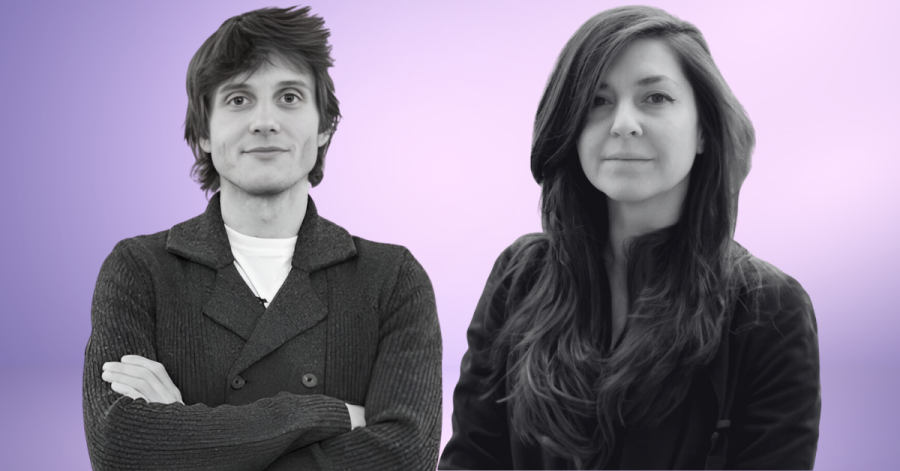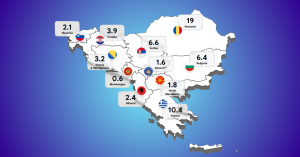In the competitive world of tech, every startup needs to find ways to stand out from the crowd. And one way to do that is by securing a startup patent for their technology or invention. Patents can provide a significant competitive edge by granting exclusive rights to prevent others from making, using, or selling the invention for a limited period of time.
“The fact that we had a patent had a significant impact on our ability to fundraise. At the stage we got our investment, we did not have a finished product yet, and no revenue, despite the one generated through crowdfunding. So, the only asset we had as a company was the IP,” Petar Zaharinov, CTO of the reusable origami bottle DiFOLD, shares.
The Recursive met with Petar Zaharinov from DiFOLD and Angela Ivanova, co-founder of LAM’ON, the startup that develops a biodegradable laminating film, to dive deep into the importance of patents for tech startups. Read further to understand how they navigated the complex world of patents and to find out whether the current patent system is truly fulfilling its intended purpose of stimulating innovation.
Applying for startup patents is a long journey
According to Petar, the process of obtaining a patent depends on the region and has a lot to do with the Patent Cooperation Treaty (PCT) which assists founders who are seeking patent protection internationally. “For example, our US application is the earliest one (filed in 2018) but is still in the office actions stage while our European one (based on an independent PCT application) was granted a year ago. In general, as a startup, we try to stretch this process as much as possible in order to postpone expenses. We usually file a provisional application, then we continue it as a PCT one, and finally, we enter the national stages where the biggest expenses are,” Petar shares.
Angela Ivanova, co-founder of LAM’ON, shares that the first thing that she and her co-founder did was to protect their trademark. “The name of a product is very important. Speaking of innovations, there are many people scouting for mistakes like this, hijacking your product’s identity for the purpose of blackmailing you afterward or just being a classic copycat somewhere in Asia. After we’ve sealed this, we continued with the ‘Freedom to operate’ in the World Intellectual Property Organization (WIPO) websites and we are currently with an official PCT request that is our ‘request for international patent’,” she explains.
What goes into a startup patent application?
Angela Ivanova says that they started off by making an assessment of current solutions on the market. “In our case, it was easy, since there is no such innovation in laminating foils, especially not on a blown film machine line, as ours. The invention relates to the method of production – reactive coextrusion.
Our strategy is to always include all known aspects of an invention in a so-called omnibus application. I always spend some time investigating if the invention is actually a special case of a bigger invention, which is also a patentable one, if it is not – to find and include all possible modifications and embodiments of the invention in order to block any design around. For example, just the drawings themselves in our main application is about 50 pages, including examples of specific products based on the invention. Since in our case, the way the product works determines the way it looks to a high extent, we also file design applications for different parts of the product to strengthen the protection and to have a faster tool to take down copycats”, Petar explains.
Patents should stimulate innovation. Do they in fact?
“The biggest challenges were related to securing the needed cash to keep all the pending applications. We have many applications in different countries, not only utility ones but also design ones, and it was a big challenge to finance them while still fighting to finish our first product, deliver it to our crowdfunding backers and then start selling on the market,” Petar shares. Likewise, Angela adds that patent prices were the biggest challenge for protecting their innovation, and this caused a slowdown in the development of LAM’ON.
According to Petar Zaharinov the current patent system in Europe is not friendly to startups and independent inventors mainly for reasons related to high expenses. He thinks the system needs deep reform, because the core ideas of patent law are to stimulate innovation, based on inventions and to protect the interests of the inventors. “With the current state of the art, it mostly disappoints inventors and finally makes them stop inventing,” Petar highlights.
He outlines that there is a fragmentation of the patent coverage map, which leads to a high cost of obtaining protection worldwide. In addition, the fees at some patent offices are unreasonably high – for example, in the EU it is between 10 and 50 times more expensive to obtain and maintain a utility patent compared to the US, although the market size is similar.
“Even with the long-awaited consolidation and the presence of the new Patent Court and the removal of the need to validate the European Patent in almost every EU country, it will still be far too expensive, this is my impression. Europe needs a radical decrease in fees,” Petar urges.
He also points out that the active period of PCT applications is way too short. “30-31 months (just 2.5 years) are a completely impossible period of time to have a product on the market, based on an abstract invention, which has already generated enough revenue to finance all the needed worldwide IP protection. It should be at least 5 years. My impression is that with the current active period, most of the startups and independent inventors fail and never invent again, which is a loss for society,” Petar explains.
Working with patent agents or going solo?
Petar says that although he is currently working with an agent, he had prepared and filed their main application himself after spending three to four years educating himself in the field.
“In my opinion, it is crucial for a startup that relies on IP to have at least one founder, preferably the inventor, that has profound knowledge in the field of patent law,” he highlights.
According to Petar, the inventor is the one who knows the invention and its industry the best, and a startup’s interests and a patent attorney’s interests are often at odds. While an attorney aims to guide the startup through the most expensive and difficult path, a startup’s interest is to postpone expenses and skip unnecessary steps. Petar advised that working with an attorney at the beginning of the process can make it too expensive, and recommends filing an omnibus provisional application first, containing comprehensive drawings and description.
“Working with an attorney at the very beginning makes the process too expensive at the most fragile stage of a startup, when every cent is important. For a provisional application, an attorney is not needed, since just one formal claim is required in order to be able to use the priority date for a later PCT application, and this claim is not even needed to be relevant. I recommend first an omnibus provisional application to be filed by the startup, containing very comprehensive drawings and description and then just before the priority period expires – to work with an attorney to polish the application and to draft claims that are at the edge between general and specific,” he says.
Should I pursue a patent at all?
“Well..this surely helps with the market positioning of a company. Apart from that depending on your goals you can always expand markets by licensing the invention and increasing your revenue with the fees. On top of that it is improving your position in front of investors,” Angela advises.
According to Petar, there are several important factors to consider when deciding whether to pursue a patent for a technology or invention. First, if the technology or product can be easily reverse-engineered and having exclusive rights to produce and sell it is critical for the company’s marketing and growth, then it is necessary to apply for a patent. On the other hand, if the technology is difficult to reverse-engineer, it may be more effective to consider trade secret protection as a more cost-effective and long-lasting option.
In cases where speed is a critical factor, such as when a company needs to be the first to market in order to establish its brand, it may not be necessary to apply for a patent. Instead, being the first to bring a product to market and establishing it as associated with the brand is more important.
Finally, if the technology in question is likely to become outdated in a short period of time (less than 5 years), then it may not be worth investing in a patent. Instead, it is more important to focus on obtaining shelf space in stores as quickly as possible. By carefully considering these factors, startups can make informed decisions about whether pursuing a patent is the right choice for their technology or invention.
Founder-to-founder advice on startup patents
“If it is recipe related – don’t rush. Consult with patent experts on the approach and make sure you’ve reached the final product before starting the market and competition research. We’ve worked with an amazing patent lawyer and his advice was of great help,” Angela recommends.
Petar advises founders who are looking to acquire a patent to have at least one founder with knowledge of patent law. In case this is not possible, he suggests dedicating one founder to educating themselves in this field. With patent law being currently like a jungle, it is crucial to get to know it in order to have any chance of survival. This knowledge will also be helpful in selecting the best guide, i.e. an attorney, to pass through this jungle. Choosing an inappropriate guide will likely result in failure.







